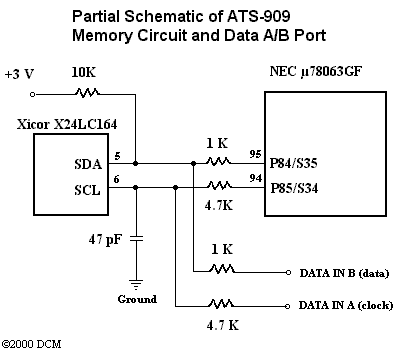The ATS-909 Memory Circuit
The following is courtesy of Jim Bowlin:
As has been suggested in this group in the past, the "Data In" connections on the bottom of the DX-398/AT-909 are indeed connected to a nonvolatile memory chip that holds all the preset information.
The diagram below shows the relevant circuit details. The X24164 is a 2048 x 8 serial EEPROM from Xicor. The uPD78063 is a microcontoller made by NEC. Both chips are powered by +3 volts. The two lines are used to both read and write data in the EEPROM.
It appears that if the NEC chip puts pins 94 and 95 into a high impedance state when they are not being used then it would be possible to read and write the preset information via the "Data In" connections on the bottom of the unit.
There are application notes on the Xicor site that explain how to interface their EEPROM chips to a PC via either an RS-232 port or the parallel printer port. Software source code is provided as well. Some modification to their interface circuit will be needed in order to connect to the radio without blowing it up.
I will be looking into this further. If anyone is successful in implementing a PC interface to these radios then all of presets could be stored and loaded from files on the PC. Also, these files could be shared and exchanged with others.
-- Jim Bowlin
About the I2C Bus
The I2C (for Inter-IC-Connection) is a two-wire serial protocol for connecting IC's within a circuit, sort of like a miniature LAN. It can handle speeds up to 1-2 KBPS. I2C has come into very wide use in TVs, radios, communications recievers, cable boxes and many other devices. It's not surprising that the Sangean 909 would use this interface.
Special power-up key sequences
There are several special key sequences that put the radio in various modes to download memory, upload it or do self-tests. Most of these involve holding down the LIGHT key plus one of the band keys, though the display test requires the RESET button on the bottom of the radio. Key sequences provided by Lindsay rabbit5@azstarnet.com
- RESET-LIGHT
- Display test--all segments of the LCD light up.
- FM-LIGHT
- Select FM band. Press FM and LIGHT simultaneously; "DATA OUT"
is displayed.
You have two seconds to hit ENTER.
Display flashes and then reads "VERIFY"
Display reads "FAILED" (without an interface connected)
It's assumed that the radio will read out memory from the EEPROM when the appropriate I2C commands are given from the external interface. - LW-LIGHT
- "DATA IN" displayed;
Power on and set band to LW
Hit LW and LIGHT at the same time; radio displays "DATA IN"
You have two seconds to hit ENTER
display flashes, then displays "VERIFY"
then "OK"
then "ROM DUMP"
then "VERIFY"
then "ROM OK"
then radio powers down. Powering up the radio will show the memory defaults. Apparently, this is the method for programming the radios at the factory.
There have been reports of a certain key combination displaying "SANGEANA" in the FM band, where SANGEANA may represent a ROM revision, but so far, this has been unreproducible. Write me, if you figure this out.
Resetting the radio's memories
The LW-LIGHT key sequence, without an interface connected, will wipe out the memories. North American users should note that this will erase the American frequencies from the radio and load the European set. Be warned!
Another method is to take a short piece of wire and short out the A and B port terminals while hitting reset. This forces a reset on the I2C bus which clears the EEPROM. The former "software" method is preferred to avoid any (slight) possibility of damage to the I/O port.
Default ROM presets for Europe/Asia
Here's a list of memory page descriptions that differ between the European/Asian models and the American.
Before After 1.Australa DW 2.Austria SWF3 3.Canada BR 4.China DLF 5.Cst Rica Rad. Ropa 6.Cuba BBC --D-- 7.Ecuador BBC --UK-- 8.England RFI --D-- 9.England RFI 10.France Radio NL 11.Germany R. Vlaand 12.Holland Schweden 13.Israel Finnland 14.Japan Roi Wien 15.Korea N SRI Bern 16.Korea S RAI Rom 17.N Zealnd REE Madr 18.Norway Vatikan 19.Russia R Slowak 20.S Africa R Polen 21.Sweeden Budapest 22.Switzlnd Russland 23.Taiwan Russland 24.U.S.A. R Kairo 25.U.S.A. R China 26.U.S.A. R Japan 27.U.S.A. R Brasil 28.U.S.A. Voice AM 29. (blank) Voice AM
Further References
- Data sheets for the NEC uDP78063
- This covers the microcontroller used in the 909
- X24164 information sheet
- X24256 datasheet [PDF]
- The X24256 superseded the X24128 & X24164 serial memory chips. The X24164 datasheet is no longer available.
- The I2C Zone
- The I2C FAQ
- Vincent Himpe's big I2C page and FAQ. Drivers, interfaces, all you need for I2C.